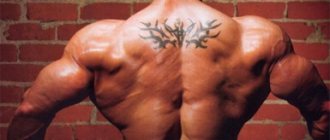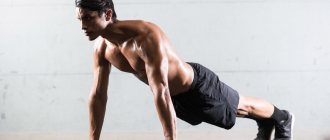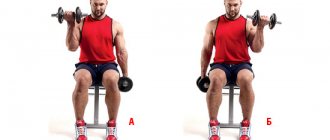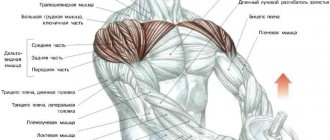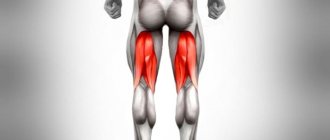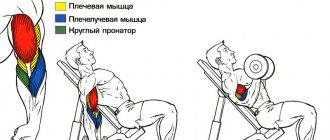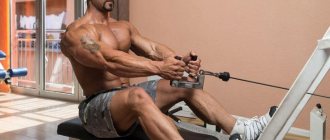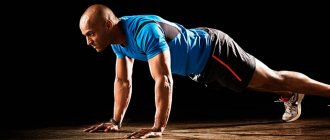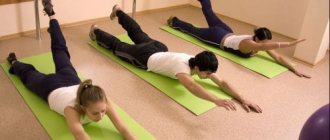Three-day split for mass is one of the most effective training programs
The three-day split is not only one of the most common training programs, but also one of the most effective.
It is used not only for gaining muscle mass and increasing strength, but also for losing weight. Dividing the training process into three parts per week allows you to effectively work out muscle groups and give them time to recover.
Advantages:
Three workouts a week is a classic not only in bodybuilding, but also in other sports. The optimal frequency of training allows the practitioner to gain muscle mass very effectively. Naturally, to improve the effect, you need to eat right and get enough sleep; muscles grow in your sleep.
Each muscle group is worked once a week. Usually this is one large + one small muscle group. For example, on the first day you train your legs and shoulders, on the second - your back and triceps, on the third - your chest and biceps.
At the beginning of training, you always first perform heavy basic exercises that involve many large and small muscle groups, then move on to lighter and isolating exercises.
Three-day mass split for beginners.
MONDAY (BACK, BICEPS)
- Deadlift 3x6-8
- Pull-ups 3x6-12
- Bent-over barbell/dumbbell row 3x6-12
- Barbell curls 3x6-12
- Hammers with dumbbells 3x6-12
WEDNESDAY (CHEST, TRICEPS, ABS)
- Bench press 3x6-8
- Incline dumbbell press 3x8-12
- Dumbbell flyes 3x8-12
- Dips 3x6-12
- French press 3x6-12
- Crunches 3x20-30
FRIDAY (LEGS, SHOULDERS)
- Squats 3x6-8
- Leg press 3x8-12
- Calf raise 3x12-15
- Seated barbell/dumbbell press 3x8-12
- Barbell row to the chin 3x8-12
- Dumbbell swings to the sides 3x10-12
Back muscle training program for weight in the gym
Back exercises are often done on the same day as chest training. Start your workout with your back muscles, as this muscle group is larger. But if your chest muscles are lagging behind, then do them first, when you have more strength.
Pull-ups
video - Pull-ups and barbell rows
Features of the technique:
- by changing the width of the grip, you can work on different areas of the back: the wider the grip, the more the lats are involved in the work, making the back wide;
- pull yourself up using the muscles of your back, not your arms - the biceps are included in the work only at the top point;
- Don't pull your shoulders towards your ears.
If you weigh little and it’s easy to pull yourself up, use a weight – a belt with a weight plate. If, on the contrary, you still can’t pull yourself up, then put the chair down and push off from it with one leg. In the gym, you can do pull-ups on a special “Graviton” simulator (the greater the weight of the counterweight, the easier it is to do pull-ups; start with a counterweight slightly lighter than your own weight).
Deadlift
video - deadlift
The deadlift is the best, but at the same time the most traumatic back exercise. The deadlift is indispensable when working on weight. The main thing is to master the correct technique and not rush to hang more weights on the barbell. To protect yourself from injury: pump up your abdominal muscles and spinal erectors. They will support the spine during the deadlift. Auxiliary exercises: hyperextension, abdominal crunches.
Deadlift Variations:
Bent-over barbell row
video - Bent-over barbell row
Bent-over barbell rows help build mass in the latissimus and trapezius dorsi muscles; this exercise should definitely be included in your mass program. All of the Deadlift tips apply to the Bent Over Row as well - master the technique and strengthen the supporting muscles before adding more weight to the barbell.
Features of the technique:
- legs slightly bent at the knees;
- back at an angle of 45%;
- spine in one straight line;
- pull the barbell to the lower abdomen, not to the chest;
- the bar slides over your thighs.
One-arm dumbbell row
video - one-arm dumbbell row
The one-arm dumbbell row is a great alternative to the bent-over barbell row. Do this exercise longer (first with one hand, then with the other), but you can work with a greater amplitude (the muscles will stretch and contract stronger). Those. you can only lift the barbell up to your stomach, and pull the dumbbell higher. Due to this, the back muscles are better “pumped”.
Features of the technique:
back parallel to the bench; pull the dumbbell with your back muscles first, the biceps are activated only at the end: you pump your back, not your arms! at the top point of the exercise, the body does not need to be turned (the back remains parallel to the bench), it is important to feel the contraction of the back muscles.
T-row on the machine
video - T bar row technique
T-row on the machine works the lats and minimizes the load on the spine
. This is necessary for those who cannot perform basic exercises with free weights due to injuries or want to “finish off” the lats after the basics without overloading the spine.
Upper block pull
video - Technique lat pulldown
The lat pull-down is an auxiliary back exercise for those who do not yet know how to do pull-ups.
Lower block thrust
video - Lower pull-down technique
The lower block row is an alternative to the bent-over barbell row; you can put it at the end of the workout to “finish off” the back muscles.
Hyperextension
video - Hyperextension technique
Hyperextension is a great exercise for the spinal erectors. It can be done either with additional weight (barbell or plate) or without.
Features of the technique:
- the hips lie on pillows in front;
- the hip bones are at the leading edge of the pads. If you move your pelvis 10 cm higher, your legs and gluteal muscles will receive more load;
- the back does not round when performing the exercise, it remains straight;
- When rising from the bottom point, the back does not hyperextend; it should be in line with the legs.
Three-day weight split for advanced
WORKOUT 1 (BACK-CHEST)
- Pull-ups with extra weighing 4x8-12
- Dumbbell/barbell bench press 4x8-12
- Bent-over barbell row 3x8-10
- Dumbbell press at an angle of 3x8-10
- Bent-over dumbbell row 3x8-10
- Lying dumbbell flyes 3x8-10
WORKOUT 2 (SHOULDERS, ARMS)
- Seated barbell/dumbbell press 4x8-12
- Barbell/dumbbell rows to the chest while standing 4x8-12
- Close grip bench press 3x8-10
- Barbell curls 3x8-10
- French press 3x8-10
- Hammers with dumbbells 3x8-10
WORKOUT 3 (LEGS, CALVES)
- Squats 4x8-12
- Deadlift 4x8-12
- Leg press 3x8-10
- Leg curls 3x8-10
- Standing calf raise 3x12-15
- Seated calf raise 3x15-20
Biceps and back training program
Consists of the following exercises:
- weighted pull-ups (5x6-8);
- one-arm dumbbell rows performed in a bent-over position (5x8-12);
- block pull to the belt (4x8-12);
- spider curls (4x8-12);
- dumbbell biceps curls performed with a hammer grip.
Weighted pull-ups
If the classic version is given without any problems, you can increase the complexity of the exercise by adding weights in the form of a chain with a weight disk to your belt. Athletes who have difficulty performing the exercise should use a resistance band that is wrapped around their lower limbs and the bar.
Many athletes “force” the biceps to do almost all the work during a pull-up by lifting the chin above the level of the bar. This, of course, allows you to work this muscle well, but without involving your back. This can be corrected by stopping the chin when it is slightly below the bar. At this top point, the latissimus dorsi muscles are tensed, that is, the desired effect is achieved.
One-arm dumbbell row
Technically correct execution of this exercise allows you to work the latissimus dorsi, rather than the shoulder muscles. To do the exercise, bend forward, bend your back, and pull the dumbbell towards you. The hands describe a movement whose trajectory resembles the Latin “J”.
Pulling the block to the belt
The palms are in a free grip, that is, facing towards each other. The elbows in this position move as close to the body as possible. To engage the target muscle groups, the torso is held at an angle of 90 degrees, without swaying.
Spider Curls
Performed on an inclined bench using one hand. The face looks down. The short head of the biceps brachii muscle is worked. The biceps are constantly kept in tension. This eliminates the involvement of other muscles. To achieve correct execution, the first repetitions are done with the free palm placed under the working elbow.
Dumbbell curls with a hammer grip for biceps
Thanks to a neutral grip, the small muscles of the flexors of the arms are worked out. Maximum hypertrophy can be achieved by prolonged muscle tension. The easiest way to achieve this is through negative repetitions. They are performed similarly to a regular set with the usual weight, but lower the dumbbells slowly, that is, for at least 4 seconds.
On topic: Pulled back muscles and got a cold
Source
Note on training.
You should switch to a three-day split after a full-body training program or a two-day split. However, it is quite common for beginners to jump straight into the 3-day beginner split. The main thing is not to overdo it with the load to avoid overtraining.
At the initial stage, it is enough to perform 2-3 approaches with small weights of 10-15 repetitions in order to establish the correct technique for performing the exercises and gradually prepare the muscles for working with large working weights.
When working on mass, trained athletes need to perform exercises with large working weights (75-80% of the maximum), 3-4 sets of 6-12 repetitions.
Rest between sets depends on your goals. When working on mass and strength, rest between approaches and exercises for 2-3 minutes. To lose weight, rest between approaches should be reduced to 30-60 seconds. Rest no more than 2 minutes between exercises.
On the subject: How to properly pump your wrist with dumbbells
Work on yourself. Today! Now!
Thanks for reading. If the article was useful, please like and subscribe.
Source
Back-Biceps-Rear Delta. Effective training program (part 4)
This is my fourth article about the push-pull training program, where we train the “pull muscles” - the back, biceps and rear deltoids.
Links to the first three parts are at the end of the article. If you're not familiar with the push-pull training program, it looks something like this:
- Day 1: Pressing Muscles
- Day 2: Traction Muscles
- Day 3: Legs
- Day 4: Rest
- Day 5: Pressing
- Day 6: Traction
- Day 7: Rest
I decided to break the article into several separate ones, since there is a lot of material. So, here we go, this article in the series will be devoted to the rear deltoids and biceps.
Exercise 5, second day. Wide grip barbell row to the chest. (rear delta)
I already have a description
this exercise, but I’m not lazy today and I’ll write it again) Take a small barbell with a wide grip.
Next, we monitor the position of the body, the back is straight, the knees are slightly bent.
To round the back (slouch) and remove the trapezius from the movement, we think as if we want to push our fists into the floor.
And pull the bar straight up to your chest, keeping your back rounded. Pull as far as possible, elbows go behind your back.
We do 4 sets of 10-12 repetitions, leaving 2 repetitions until failure.
Exercise 6, second day. Standing EZ-Barbell Curl.
Considering the amount of load we did on the back in the last part, there is no need to waste too much time training the biceps; they have already done a good job. But you don’t need to forget about him either.
Everyone knows this exercise. We try to keep our elbows in place, not bend our hands too much, and not help with our whole body. You can also use a barbell with a straight bar, but this often leads to injuries to the wrist joint. It depends on who. We do 2-3 sets of 6-8 repetitions, leaving 1-2 repetitions until failure.
Exercise 7, second day. (OPTIONAL) Bent-over dumbbell raises for biceps.
You can do this exercise if you want to maximize biceps development and can handle a higher volume of work.
This exercise is generally aimed at fatigue of the biceps; it can be done both with supination (turning the wrist outward) and without it. I prefer with it, it allows you to feel the biceps better, at least for me. We place the bench at an angle of about 60 degrees, we try to minimize the participation of the body in the movement, only the elbow bends, that’s all. You don't need a lot of weight. We do 2 sets of 15-20 repetitions.
End of the fourth part. Part 5 HERE.
If you found the article interesting and want to continue, please give it a thumbs up and subscribe

